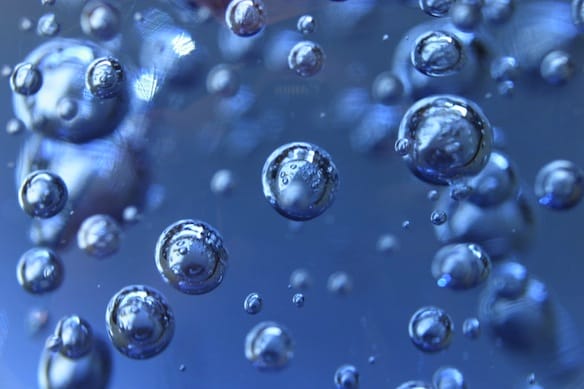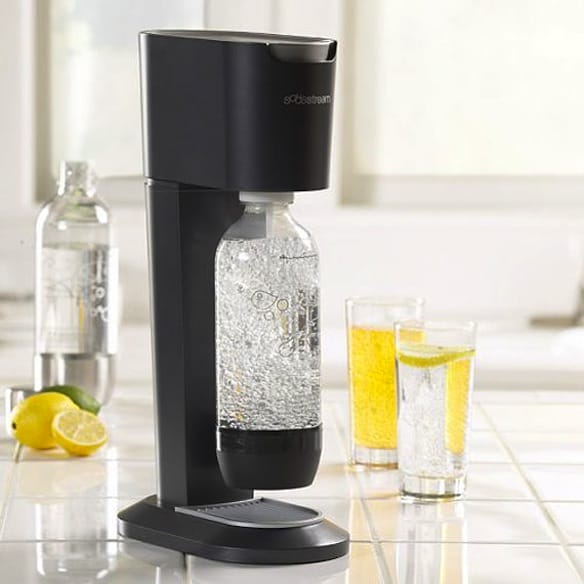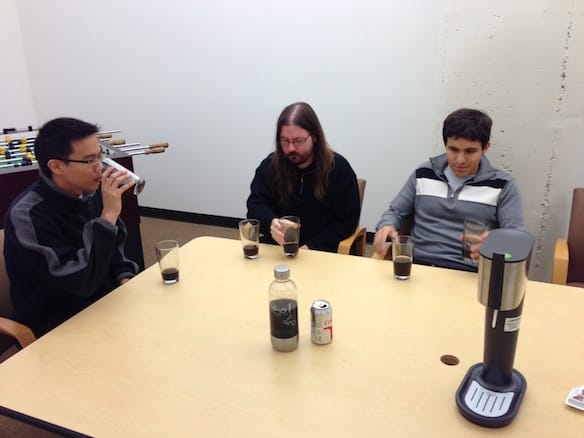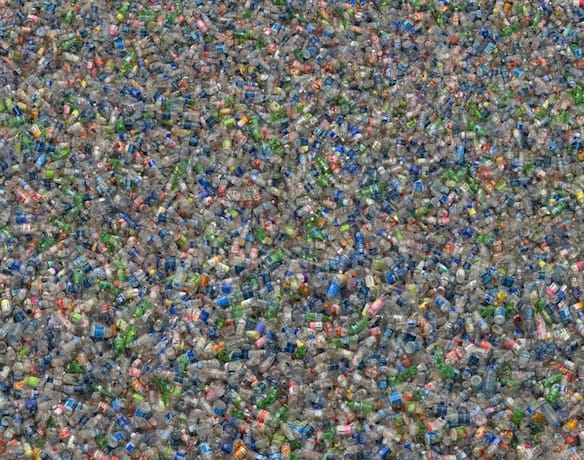Ah fizzy water. It’s hard not to feel fancy and carefree when enjoying a nice glass of carbonated water. It’s refreshing like a cold drink of spring water, yet the bubbles gently tickle your mouth ever so playfully. This must be what it feels like to be European!

Image credit: deviantART.
This author hasn’t always been a fizzy water fanatic. However, having recently received a SodaStream as a wedding present, seltzer water now flows freely in his household. The contraption lets you carbonate water at home quickly and easily. Just fill up your SodaStream bottle with water, screw the bottle into the device and pull a lever, then voilà! You have carbonated water.
The SodaStream feels like a magic well of free carbonated water until you realize it’s not free. Even though you’re making the sparkling water yourself, beverages from the SodaStream cost cold hard cash, just like buying the water from a store. You need to invest in the device, replacement CO2 cartridges, and other items that cost money.
Do you actually save money making your own sparkling water using a SodaStream? What about if you use it to make homemade soda? As it turns out, you probably don’t.
Background on SodaStream
SodaStream as a company is a remarkable business story. Though founded in 1903, the company was fairly unsuccessful until very recently. In 2006, private equity firm Fortissimo bought the company for $10 million. Today, they have a market capitalization of $845 million and are on track to do over $400 million in revenue in 2012. Well played, Fortissimo!

SodaStream in glorious action! Image credit: SodaStream.
In very quick time, the company has successfully built a global retail network of places like Costco, Bed Bath & Beyond and Williams Sonoma to distribute its bubbly wares. Not only do these stores sell the carbonators, but also SodaStream’s proprietary CO2 cartridges, bottles and soda mixes.
These “consumables” are sold at outrageously high margins (CO2 cartridges for $15+, plastic soda bottles for $10 each!) and make up over 50% of the company’s revenues. It goes without saying that you can’t use generic CO2 capsules and water bottles with your SodaStream. Razors and razor blades, a very nice business model.
Economics of Homemade Carbonated Water
So, how much does it cost to make carbonated water using a SodaStream? Is it actually a good deal versus buying seltzer water at a grocery store?
The main costs associated with the SodaStream are the upfront investment and the CO2 usage each time you make a bottle. The devices cost between $80 to $200 depending on the model. One CO2 cartridge costs $17 at Cole Valley Hardware in SF. This $17 cartridge can produce 60 liters of water ($0.28 per liter). When you buy the carbonator it comes bundled with a cartridge, so the “device only” upfront cost of the carbonator is really only $63 to $183 (purchase price less CO2 cartridge).
The SodaStream Pure is a midrange device (and what this author has) that costs $130 which we’ll use for this analysis. Backing out the price of the CO2 cartridge, the device costs $113. Every time you make a liter of soda it costs you $0.28 in carbon dioxide expense. That seems like a pretty good price! How much are you saving making your own carbonated water versus buying it and when will you recoup the upfront investment in the device?
How much you save by using a SodaStream is a very tricky question. It depends on the cost of the water that you are consuming before you buy a SodaStream. That can vary quite a bit.
If you’re happily chugging regular ole tap water today, switching to SodaStream will cost you big time! While a liter of San Francisco tap water costs about 1/10 of a penny per liter, a liter of SodaStream is 280X expensive! Like many internet business models, there is no way you’ll break even with those economics.
But say you’re an avid fizzy water drinker, drinking two liters a week (about what this author consumes). Since the SodaStream produces one liter of carbonated water at a time, how much do you save versus buying similar one liter bottles from Safeway.
Safeway brand carbonated water is fairly cheap, $0.89 for a liter bottle (and almost twice as cheap per liter if you spring for a two liter sized bottle). Since the SodaStream costs $0.28 per liter, you save $0.61 per liter! So how long will it take you to pay back your investment in the device ($113)?
It takes 93 weeks or almost two years to pay back the investment. If you only drink a liter of sparkling water every two weeks, it would take over seven years! If you normally buy 2 liter bottles of water from Safeway, it will take much longer.
Your investment can pay off sooner if you purchase the least expensive SodaStream (or later if you purchase a more expensive one).
But if you’re only a casual consumer of bubbly water, you might be using an iPhone 15 when your SodaStream breaks even.
So, is a SodaStream a terrible investment? Well, yeah. If it causes you to drink more sparkling water instead of tap water, it’s a luxury purchase and in no way an investment. But that’s okay, most of the things we buy aren’t investments.
But what if you already drink a lot of sparkling water and want to get the SodaStream to save money? As a rule of thumb, if you drink about a liter per week, you’ll be better off with a SodaStream (assuming you hold on to it for about 3 years). If you don’t, you’ll save more money just buying water from the store. Also, if you buy the least expensive SodaStream model and normally drink a couple of liters a week, the investment can pay off in a year. If you normally stock up on 2 liters bottles of carbonated water from the grocery store, the SodaStream investment will almost certainly never pay off.
But This Thing Makes Soda Too
One neat thing about the SodaStream is you can add flavors to the carbonated water and make your own soda. Soda is expensive so surely you can save money this way! The bottles of flavor syrup cost $5 each and make 12 liters of soda. Add that to your carbonation costs, and you can make soda for $0.70 per liter. How does this compare to buying soda at the grocery store? We walked over to the grocery section of our local SF Walgreens to find out the Coca-Cola pricing per liter by container type:
Given that the average American consumes 170 liters of soda a year (whoa!), you can recoup your investment in a SodaStream Pure in about 2 years if you normally drink from 2 liter or 1.25 liter bottles at home. If you drink from cans or 16.9oz bottles at home, you can break even much faster.
But How Do These Sodas Taste?
So, all soda drinkers should rush out and start rolling their own soda, right? Before we set our stash of Diet Coke cans on fire, the team at Priceonomics decided to do a taste test of SodaStream sodas versus the real thing. We did a blind taste test between their “Dr. Pepper” and the real thing and their “Diet Coke” and the real thing.

The cola connoisseurs of team Priceonomics rating sodas.
The SodaStream “Dr. Pepper” actually tasted pretty good! However, the whole team was able to identify which glass contained the real thing and they did somewhat prefer the taste of real Dr. Pepper.
The “Diet Coke” was a bit of a disaster. Not only was the “fake” easily identifiable, but it tasted pretty bad. No one on the team would be happy to have the homemade version replace our real Diet Coke, no matter how much money we saved.
We also tried out the SodaStream “Red Bull”. Unfortunately the quality of our code was only 85% as good as when we were drinking real Red Bull. Just kidding, our code was fine, but the energy drink left much to be desired.
Conclusion and Other Considerations

Image credit: Chris Jordan.
Much of the appeal of the SodaStream is that you don’t need to waste lots of plastic bottles buying carbonated water and soda from the store. That said, how many bottles of carbonated water do you actually buy per year? If you aren’t actually buying many today, you aren’t saving many bottles by getting a SodaStream. You don’t get any environmentally friendly credits! And while people waste lots of soda bottles, most soda drinkers would mutiny if you presented them with these homemade imitation sodas – the taste just isn’t there.
For the vast majority of people the only way to justify a SodaStream purchase is as a luxury purchase. You’ll likely substitute some of your nearly free tap water consumption with carbonated water consumption that is 280x as expensive. That’s probably okay though since fizzy water is tasty and fun. And while the SodaStream water is more expensive, it only costs a couple of nickels per cup; as indulgences go, it’s relatively affordable.
This post was written by Rohin Dhar. Follow him on Google or Twitter here. He’s probably in trouble for criticizing his wife’s favorite possession in this post. Get the latest from Priceonomics on Facebook or Twitter.



